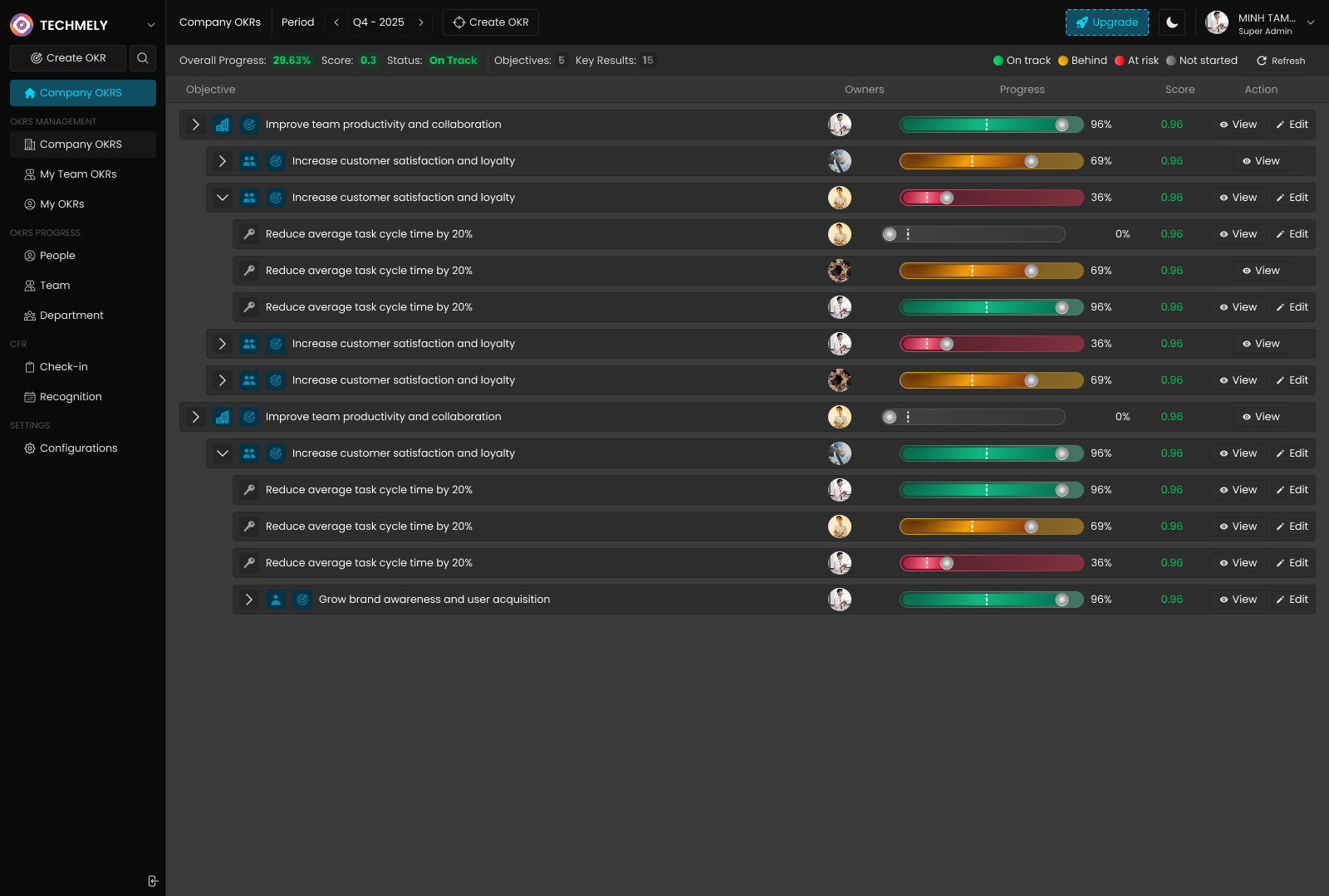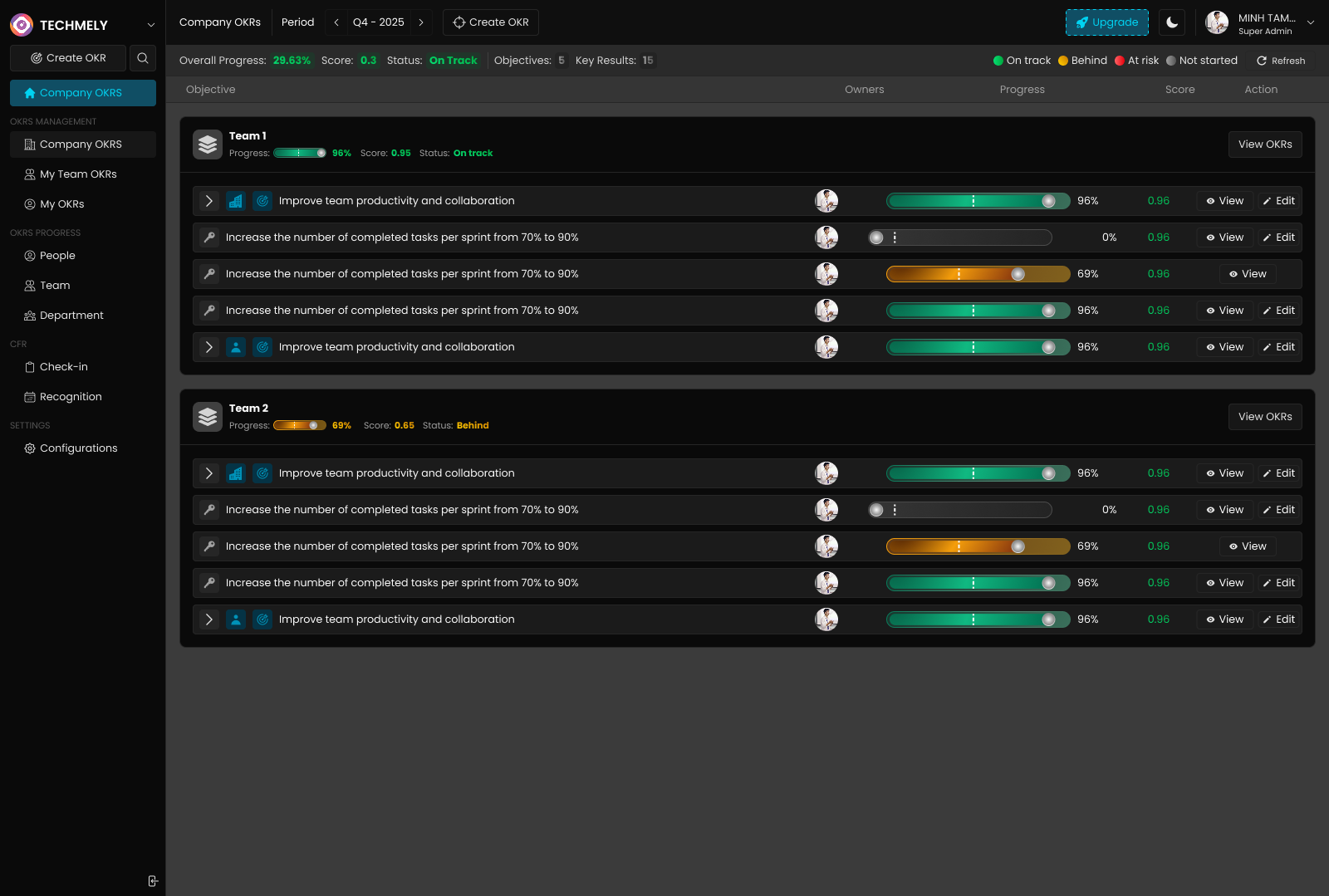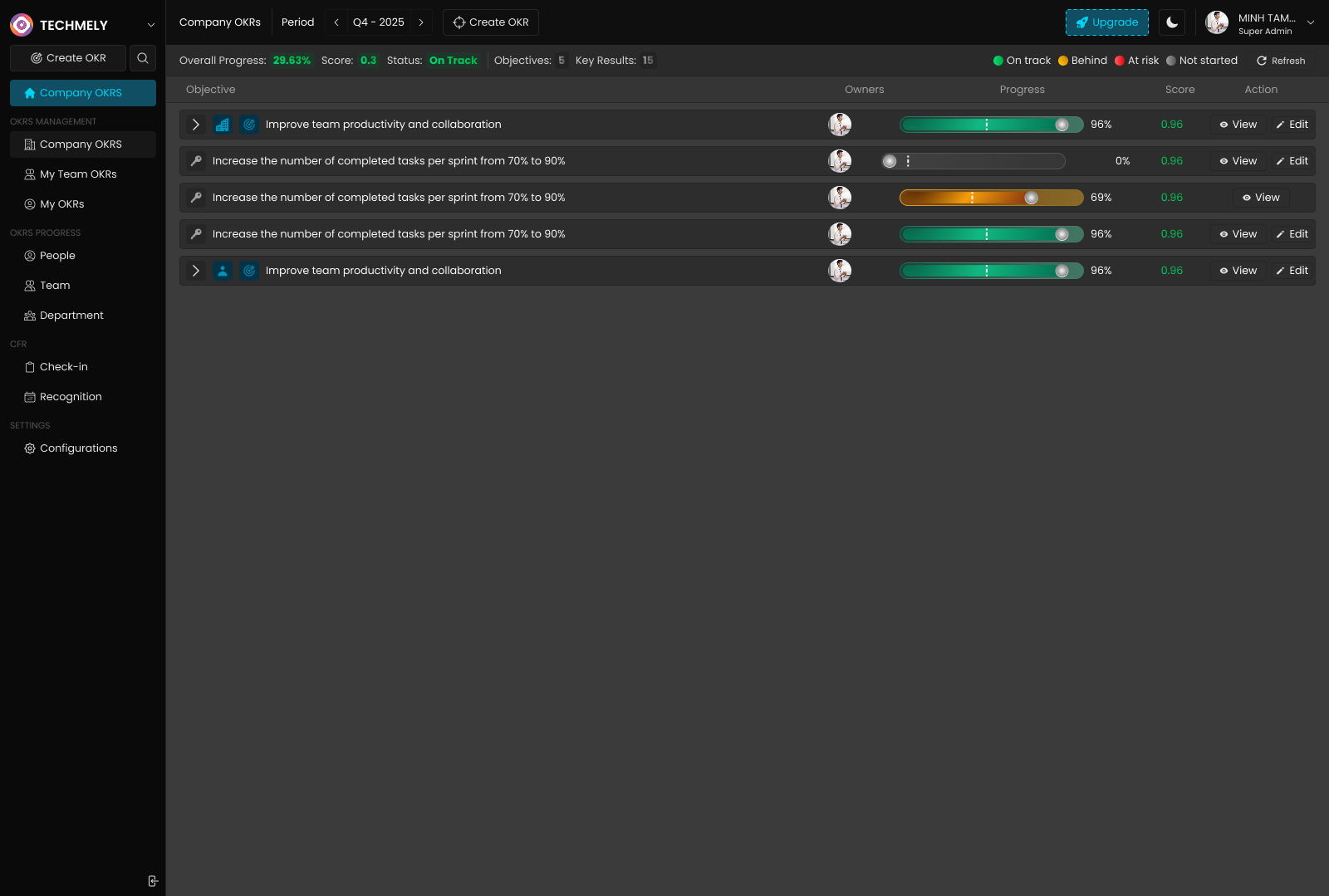OKR Management Overview
Complete guide to navigating and understanding OKR management interface across Company, Team, and Personal levels
OKR Management Overview
Overview
The OKR Management interface is your central command center for monitoring, tracking, and managing objectives and key results across all levels of your organization. This comprehensive dashboard provides real-time visibility into progress, performance, and alignment from company-wide strategic goals down to individual personal objectives.
Understanding the OKR Management Interface
The OKR Management dashboard presents a hierarchical view of all organizational objectives, allowing you to:
- Monitor Progress: Track completion status across all levels
- Assess Performance: Evaluate individual and team contributions
- Identify Risks: Spot potential issues before they become blockers
- Ensure Alignment: Verify strategic connection between levels
- Drive Accountability: Maintain ownership and responsibility clarity
Key Interface Elements
Header Information:
- Overall Progress: Aggregate completion percentage across all objectives
- Score: Numerical performance indicator (0.0 - 1.0 scale)
- Status: Overall health indicator (On track, Behind, At risk)
- Objectives Count: Total number of active objectives
- Key Results Count: Total number of active key results
- Period Selection: Time frame filter (Q4 - 2025)
Progress Indicators:
- 🟢 On track: Meeting or exceeding expectations
- 🟡 Behind: Some delays but recoverable
- 🔴 At risk: Significant risk of failure
- ⚫ Not started: No progress recorded yet
Company-Level OKR Management
Company OKRs represent the highest strategic priorities and provide the foundation for organizational alignment.

Key Features of Company View
Strategic Overview:
- High-Level Objectives: Organization-wide strategic goals
- Executive Ownership: C-level and senior leadership accountability
- Cascading Impact: Foundation for team and personal OKRs
- Resource Allocation: Guides budget and resource decisions
- Performance Metrics: Company-wide success indicators
Interface Elements:
Objective Hierarchy:
- Expandable Objectives: Click arrows to view key results
- Progress Visualization: Color-coded progress bars
- Owner Information: Responsible executives and leaders
- Score Display: Numerical achievement indicators
- Action Buttons: View and Edit options for authorized users
Typical Company Objectives:
- "Improve team productivity and collaboration" (96% complete)
- "Increase customer satisfaction and loyalty" (36-69% range)
- "Grow brand awareness and user acquisition" (96% complete)
Company OKR Characteristics
Strategic Focus:
- Long-term organizational outcomes
- Market position and competitive advantage
- Financial performance and growth
- Customer satisfaction and retention
- Innovation and product development
Measurement Approach:
- High-level aggregate metrics
- Cross-departmental performance indicators
- Market-based success measures
- Financial and operational KPIs
- Strategic milestone achievements
Stakeholder Involvement:
- Board of directors and investors
- Executive leadership team
- Department heads and VPs
- All employees (visibility and alignment)
- External partners and stakeholders
Team-Level OKR Management
Team OKRs translate company strategy into departmental and functional execution plans.

Team Organization Structure
Team Grouping: Teams are organized in expandable sections showing:
- Team Name: Clear departmental identification
- Overall Progress: Aggregate team performance percentage
- Team Score: Numerical achievement indicator
- Status: Health indicator (On track, Behind, At risk)
- View OKRs Button: Access to detailed team objective view
Example Team Structure:
- Team 1: Progress 96%, Score 0.95, Status: On track
- Team 2: Progress 69%, Score 0.95, Status: Behind
Team OKR Characteristics
Functional Alignment:
- Department-specific objectives
- Cross-functional collaboration goals
- Resource optimization targets
- Process improvement initiatives
- Capability development objectives
Execution Focus:
- Tactical implementation of company strategy
- Measurable operational outcomes
- Service delivery improvements
- Quality and efficiency metrics
- Team performance indicators
Collaboration Elements:
- Inter-team dependencies
- Shared resources and goals
- Communication requirements
- Coordination checkpoints
- Collective accountability
Team Performance Indicators
Progress Tracking:
- Individual objective completion rates
- Key result achievement levels
- Milestone completion status
- Resource utilization efficiency
- Timeline adherence metrics
Quality Metrics:
- Output quality standards
- Customer satisfaction scores
- Error rates and corrections
- Process efficiency measures
- Innovation and improvement contributions
Personal-Level OKR Management (My OKRs)
Personal OKRs focus on individual development, performance, and contribution to team success.

Personal OKR Interface
Individual Focus: The "My OKRs" view provides personal objective management with:
- Personal Objectives: Individual goals and development targets
- Progress Tracking: Personal achievement monitoring
- Skill Development: Capability building objectives
- Performance Goals: Individual contribution targets
- Career Advancement: Professional growth objectives
Personal OKR Categories
Performance Objectives:
- Individual productivity targets
- Quality and accuracy goals
- Customer interaction improvements
- Project delivery objectives
- Innovation and creativity initiatives
Development Goals:
- Skill acquisition and enhancement
- Certification and training completion
- Mentoring and coaching activities
- Leadership development initiatives
- Cross-functional learning objectives
Contribution Targets:
- Team support and collaboration
- Knowledge sharing and documentation
- Process improvement suggestions
- Cultural and value demonstration
- Organizational citizenship behaviors
Personal Progress Management
Self-Assessment:
- Regular progress updates and reviews
- Honest evaluation of achievement levels
- Identification of challenges and blockers
- Recognition of accomplishments and successes
- Planning for upcoming activities and milestones
Development Planning:
- Skill gap analysis and planning
- Learning resource identification
- Mentorship and coaching arrangements
- Career path alignment and progression
- Performance improvement strategies
Key Terminology and Concepts
Progress and Status Indicators
Progress Percentage:
- 0-25%: Early stage, significant work remaining
- 26-50%: Moderate progress, halfway to completion
- 51-75%: Good progress, on track for achievement
- 76-100%: Near completion or fully achieved
Status Classifications:
- On Track (Green): Progress meeting or exceeding expectations
- Behind (Yellow): Some delays but recoverable with effort
- At Risk (Red): Significant risk of not achieving target
- Not Started (Gray): No progress recorded or initiated
Score Calculation:
- 0.0-0.3: Poor performance, significant improvement needed
- 0.4-0.6: Below expectations, requires attention and support
- 0.7-0.8: Good performance, meeting most expectations
- 0.9-1.0: Excellent performance, exceeding expectations
Organizational Hierarchy
Cascade Structure:
- Company Level: Strategic organizational objectives
- Department Level: Functional and departmental goals
- Team Level: Operational and project-specific targets
- Individual Level: Personal development and contribution goals
Alignment Principles:
- Top-Down: Strategic priorities flow from company to individual
- Bottom-Up: Individual insights inform strategic planning
- Cross-Functional: Horizontal alignment between teams and departments
- Temporal: Quarterly and annual objective coordination
Interface Navigation
Expandable Hierarchies:
- ▶ Arrow (Collapsed): Click to expand and view key results
- ▼ Arrow (Expanded): Click to collapse and hide details
- 📊 Building Icon: Company-level objectives
- 👥 Team Icon: Team or department objectives
- 👤 Person Icon: Individual or personal objectives
Action Buttons:
- 👁 View: Access detailed objective information
- ✏ Edit: Modify objective or key result details
- View OKRs: Navigate to complete team objective listing
Best Practices for OKR Management
Regular Review Cycles
Daily Monitoring:
- Quick progress checks and status updates
- Identification of immediate blockers or issues
- Team coordination and communication needs
- Resource requirement assessments
Weekly Reviews:
- Comprehensive progress analysis
- Team alignment and coordination meetings
- Risk identification and mitigation planning
- Resource allocation and priority adjustments
Monthly Assessments:
- Strategic alignment verification
- Performance trend analysis
- Quarterly projection and planning
- Stakeholder communication and reporting
Effective Use of the Management Interface
Navigation Efficiency:
- Use hierarchy expansion to focus on relevant areas
- Leverage filtering and search capabilities
- Bookmark frequently accessed objectives
- Utilize dashboard customization options
Progress Monitoring:
- Regular status indicator checks
- Trend analysis over time periods
- Comparative performance assessment
- Early warning system activation
Stakeholder Engagement:
- Transparent progress sharing
- Collaborative problem-solving
- Recognition and celebration of achievements
- Continuous feedback and improvement
Troubleshooting Common Issues
Performance Problems
Low Progress Rates:
- Root Cause Analysis: Identify underlying issues
- Resource Evaluation: Assess adequacy of support and tools
- Priority Clarification: Ensure clear understanding of importance
- Timeline Adjustment: Consider realistic deadline modifications
Status Deterioration:
- Immediate Intervention: Provide additional support or resources
- Stakeholder Escalation: Involve appropriate leadership
- Strategy Modification: Adjust approach or methodology
- Recovery Planning: Develop specific improvement actions
Interface and Technical Issues
Display Problems:
- Browser Refresh: Clear cache and reload page
- Permission Verification: Ensure appropriate access rights
- Network Connectivity: Check internet connection stability
- Technical Support: Contact IT support for persistent issues
Data Accuracy:
- Source Verification: Confirm data input accuracy
- Calculation Review: Validate progress calculations
- Synchronization Check: Ensure real-time data updates
- Manual Verification: Cross-check with alternative sources
Advanced Management Features
Filtering and Search
Filter Options:
- Status: Filter by On track, Behind, At risk, Not started
- Owner: Show objectives by specific individuals
- Team: Display specific team or department objectives
- Progress Range: Filter by completion percentage ranges
Search Capabilities:
- Keyword Search: Find objectives by title or description
- Owner Search: Locate objectives by responsible person
- Tag Search: Find objectives by assigned categories or tags
- Date Range: Filter by creation or deadline dates
Reporting and Analytics
Progress Reports:
- Summary Dashboards: High-level progress overviews
- Detailed Analytics: Comprehensive performance analysis
- Trend Analysis: Historical progress patterns and projections
- Comparative Reports: Cross-team and cross-period comparisons
Export Capabilities:
- Data Export: Download objective and progress data
- Report Generation: Create formatted progress reports
- Dashboard Sharing: Share views with stakeholders
- Integration Support: Connect with external tools and systems
Next Steps
After understanding the OKR Management interface:
- Establish Review Routines: Create regular monitoring schedules
- Train Team Members: Share knowledge and best practices
- Customize Views: Tailor interface to your specific needs
- Integrate Workflows: Incorporate OKR reviews into regular processes
- Continuous Improvement: Refine approaches based on experience and feedback
Related Topics
- View OKR Details - Deep dive into individual objective management
- Create Company OKR - Setting up strategic objectives
- Create Team OKR - Establishing departmental goals
- Create Personal OKR - Individual objective setting
- Manage OKR Actions - Editing and updating objectives
The OKR Management interface is your primary tool for maintaining organizational alignment and driving successful outcomes. By mastering this dashboard, you can effectively monitor progress, identify opportunities, and ensure your organization stays focused on what matters most.
Suggested Related Articles
Create Company-Level OKR
Complete guide to creating company-level Objectives and Key Results in AntOKR
OKR Progress Tracking
Complete guide to tracking and monitoring OKR progress across departments, teams, and individuals with detailed analytics and insights
Department Management
Complete guide to creating, managing, and organizing departments and teams within your AntOKR organization
Login
How to access your AntOKR account
Manage OKR Actions
Complete guide to managing OKR actions including editing, updating, linking, and deleting objectives and key results
Create Company
Learn how to set up your company profile in AntOKR with step-by-step instructions